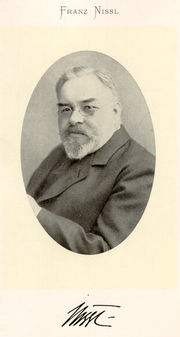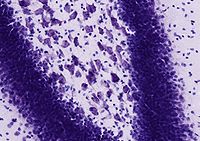
Franz Nissl
Encyclopedia

Germany
Germany , officially the Federal Republic of Germany , is a federal parliamentary republic in Europe. The country consists of 16 states while the capital and largest city is Berlin. Germany covers an area of 357,021 km2 and has a largely temperate seasonal climate...
medical researcher. He was a noted neuropathologist.
Early life
Nissl was born in FrankenthalFrankenthal
Frankenthal is a town in southwestern Germany, in the state of Rhineland-Palatinate.- History :Frankenthal was first mentioned in 772. In 1119 an Augustinian monastery was built here, the ruins of which — known, after the founder, as the Erkenbertruine — still stand today in the town...
to Theodor Nissl and Maria Haas. Theodor taught Latin in a Catholic school and desired that Franz become a priest. However Franz entered the Ludwig Maximilian University of Munich to study medicine
Medicine
Medicine is the science and art of healing. It encompasses a variety of health care practices evolved to maintain and restore health by the prevention and treatment of illness....
.
One of Nissl's university professors was Bernhard von Gudden
Bernhard von Gudden
Johann Bernhard Aloys von Gudden was a German neuroanatomist and psychiatrist born in Kleve.In 1848 he earned his doctorate from the University of Halle, and became an intern at the asylum in Siegburg under Carl Wigand Maximilian Jacobi...
. His assistant, Sigbert Josef Maria Ganser
Sigbert Josef Maria Ganser
Sigbert Josef Maria Ganser was a German psychiatrist born in Rhaunen. He earned his medical doctorate in 1876 from the University of Munich. Afterwards he worked briefly at a psychiatric clinic in Würzburg, and later as an assistant to neuroanatomist Bernhard von Gudden in Munich...
suggested that Nissl write an essay on the pathology of the cells of the cortex of the brain. When the medical faculty offered a competition for a prize in neurology
Neurology
Neurology is a medical specialty dealing with disorders of the nervous system. Specifically, it deals with the diagnosis and treatment of all categories of disease involving the central, peripheral, and autonomic nervous systems, including their coverings, blood vessels, and all effector tissue,...
in 1884, Nissl did undertake the brain-cortex study. He used alcohol as a fixative and developed a staining technique that allowed demonstrating several new nerve-cell constituents. Nissl won the prize, and wrote his doctoral dissertation on the same topic in 1885.
Career in medical research and education
Professor von Gudden was the judge in Nissl's college-essay competition, and he was so impressed with the study that he offered Nissl an assistantship at the Oberbayerische Kreis-Irrenanstalt Haar in Munich which von Gudden headed. Nissl accepted, and remained in that post from 1885 until 1888. In 1888 Nissl moved to the Institution Blankenheim. In 1889 he went to Frankfurt as second in position under Emil Sioli (1852–1922) at the Städtische Irrenanstalt. There he met neurologist Ludwig EdingerLudwig Edinger
Ludwig Edinger was an influential German anatomist and neurologist and co-founder of the University of Frankfurt. In 1914 he was also appointed the first German professor of neurology....
and neuropathologist Karl Weigert
Karl Weigert
Karl Weigert, Carl Weigert was a German Jewish pathologist.He received his education at the universities of Berlin, Vienna, and Breslau, graduating in 1868...
, who was developing a neuroglial stain. This work motivated Nissl to study mental and nervous diseases by relating them to observable changes in glial cell
Glial cell
Glial cells, sometimes called neuroglia or simply glia , are non-neuronal cells that maintain homeostasis, form myelin, and provide support and protection for neurons in the brain, and for neurons in other parts of the nervous system such as in the autonomous nervous system...
s, blood elements, blood vessel
Blood vessel
The blood vessels are the part of the circulatory system that transports blood throughout the body. There are three major types of blood vessels: the arteries, which carry the blood away from the heart; the capillaries, which enable the actual exchange of water and chemicals between the blood and...
s and brain tissue
Human brain
The human brain has the same general structure as the brains of other mammals, but is over three times larger than the brain of a typical mammal with an equivalent body size. Estimates for the number of neurons in the human brain range from 80 to 120 billion...
in general.
In Frankfurt Nissl became acquainted with Alois Alzheimer
Alois Alzheimer
Aloysius "Alois" Alzheimer, was a German psychiatrist and neuropathologist and a colleague of Emil Kraepelin. Alzheimer is credited with identifying the first published case of "presenile dementia", which Kraepelin would later identify as Alzheimer's disease....
, and they collaborated over seven years. They became close friends, jointly editing the Histologische und histopathologische Arbeiten über die Grosshirnrinde (1904–1921).
In 1895 Emil Kraepelin
Emil Kraepelin
Emil Kraepelin was a German psychiatrist. H.J. Eysenck's Encyclopedia of Psychology identifies him as the founder of modern scientific psychiatry, as well as of psychopharmacology and psychiatric genetics. Kraepelin believed the chief origin of psychiatric disease to be biological and genetic...
invited Nissl to become assistant physician at the University of Heidelberg. By 1904 he was a full professor at that institution, and became director of the Department of Psychiatry when Kraepelin moved to Munich.
Later life and death
The burden of teaching and administration, combined with poor research facilities, forced Nissl to leave many scientific projects unfinished. He also suffered from a kidney disease. During World War IWorld War I
World War I , which was predominantly called the World War or the Great War from its occurrence until 1939, and the First World War or World War I thereafter, was a major war centred in Europe that began on 28 July 1914 and lasted until 11 November 1918...
he was charged with administering a large military hospital.
In 1918 Kraepelin again invited Nissl to accept a research position at the Deutsche Forschungsanstalt für Psychiatrie in Munich. After one year at that position, where he performed research alongside Korbinian Brodmann
Korbinian Brodmann
Korbinian Brodmann was a German neurologist who became famous for his definition of the cerebral cortex into 52 distinct regions from their cytoarchitectonic characteristics.-Life:...
and Walther Spielmeyer
Walther Spielmeyer
Walther Spielmeyer was a German neuropathologist who was a native of Dessau. He studied medicine at the University of Halle under Eduard Hitzig , and in 1906 went to Freiburg, where he was an assistant to Alfred Hoche...
, he died in 1919 of kidney disease.
Personal
Nissl was of small stature, with poor posture. He had a birthmark on his left face. He never married, and his life revolved entirely around his work.One day, for a practical joke, Nissl (who was an active campaigner against human consumption of alcohol) placed a row of empty beer bottles outside his laboratory and made sure that Kraepelin heard that he could be found lying under his desk, dead drunk.
Nissl was a competent pianist. Hugo Spatz (1888–1969) told of his first meeting, when Spatz applied for a position in Nissl's laboratory. Nissl was busy that morning and asked the student to come to his home at twelve. When Spatz came to the house at noon, Nissl was not there, and the housekeeper finally opined that the Professor must have meant twelve midnight, so Spatz returned that night. Nissl was at home then, but Spatz had to wait in the anteroom for half an hour until Nissl had finished the piano sonata that he was playing. The conversation lasted until daybreak.
Legacy
Nissl was possibly the greatest neuropathologist of his day and also a fine clinician who popularised the use of spinal puncture, which had been introduced by Heinrich QuinckeHeinrich Quincke
Heinrich Irenaeus Quincke was a German internist and surgeon. His main contribution to internal medicine was the introduction of the lumbar puncture for diagnostic and therapeutic purposes...
.
Nissl also examined the neural connections between the human cortex and thalamic nuclei; he was in the midst of this study at the time of his death.
An example of his research philosophy is taken from his 1896 writings:
- As soon as we agree to see in all mental derangements the clinical expression of definite disease processes in the cortex, we remove the obstacles that make impossible agreement among alienists.

Named histology concepts
The Nissl method refers to staining of the cell body, and in particular endoplasmic reticulumEndoplasmic reticulum
The endoplasmic reticulum is an organelle of cells in eukaryotic organisms that forms an interconnected network of tubules, vesicles, and cisternae...
. This is done by using various basic dyes (e.g. aniline
Aniline
Aniline, phenylamine or aminobenzene is an organic compound with the formula C6H5NH2. Consisting of a phenyl group attached to an amino group, aniline is the prototypical aromatic amine. Being a precursor to many industrial chemicals, its main use is in the manufacture of precursors to polyurethane...
, thionine, or cresyl violet
Cresyl violet
Cresyl violet is an organic compound with the chemical formula C19H18ClN3O. It is used in biology and medicine as a histological stain. Cresyl violet is an effective and reliable stain used for light microscopy sections. Initially, tissue sections are ‘defatted’ by passing through graded dilutions...
) to stain the negatively charged RNA
RNA
Ribonucleic acid , or RNA, is one of the three major macromolecules that are essential for all known forms of life....
blue, and is used to highlight important structural features of neurons. The Nissl substance (rough endoplasmic reticulum) appears dark blue due to the staining of ribosomal RNA, giving the cytoplasm a mottled appearance. Individual granules of extranuclear RNA are named Nissl granules (ribosomes). DNA present in the nucleus
Cell nucleus
In cell biology, the nucleus is a membrane-enclosed organelle found in eukaryotic cells. It contains most of the cell's genetic material, organized as multiple long linear DNA molecules in complex with a large variety of proteins, such as histones, to form chromosomes. The genes within these...
stains a similar color.

